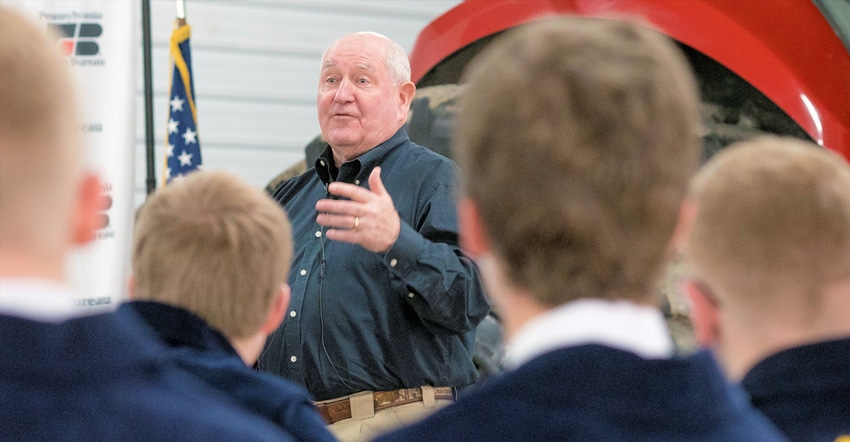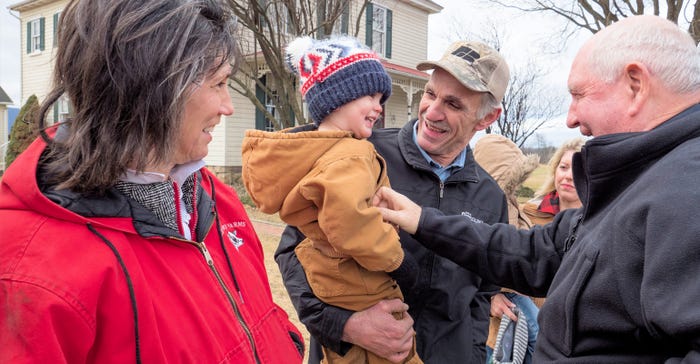
U.S. Agriculture Secretary Sonny Perdue introduced USDA’s Farm Program priority list last week during an 11-hour, six-stop run across Pennsylvania. Reinford Farms, an innovative dairy near Mifflintown, was the third stop.
When the nation’s top agricultural official visits, it’s a big thing. That was the case at Reinford Farms, where close to 100 farmers, ag leaders and officials, a flock of FFA members plus a gaggle of media people wandered restlessly out into the cold breeze, then back inside the machine shed/event center, waiting for Perdue to arrive.
Perdue was heartily welcomed by Steve and Gina Reinford and their next-gens — sons Brett, Chad and Drew, and daughter Dove — and their family’s small next-gens. After a quick farmstead tour and lunch, Perdue opened this segment of his town meeting tour by outlining the Trump administration’s nine-point farm bill guidance plan for Congress.
Perdue pointed out that the administration’s No. 1 goal is to strengthen risk management principles instead of relying on direct payments — to provide an adequate safety net that ensures a safe and consistent food supply. That means a variety of innovative risk management insurance programs to help farmers make sound production decisions and manage risks. The secretary also pledged continued support for voluntary conservation and cost-effective financial assistance for improved oil, water and air quality.
Trade was Perdue’s No. 2 issue. “With 20% of farm income coming from foreign trade, we have to make certain we have a reliable market base for our products.”
“There has been a lot of anxiety over the president’s comments about trade,” Perdue said. “But off the campaign floor, he understands. He’s a tough negotiator. We didn’t get the best deals under the past administration.”
USDA will continue its push for cutting “regulatory burdens” and monitors other countries that “impede U.S. ag exports.” Perdue pointed out Canada’s dairy industry as an example of a past NAFTA negotiation loophole that put U.S. producers at a disadvantage. “That has to be addressed,” he said.
 SEEING THE FUTURE: The ‘grandfather side’ of Sonny Perdue focused in on Gina and Steve Reinford’s grandson.
SEEING THE FUTURE: The ‘grandfather side’ of Sonny Perdue focused in on Gina and Steve Reinford’s grandson.

Food and nutritional assistance is also at the top of this list. The administration’s position is perhaps the most controversial. “We want to energize people receiving Supplemental Nutrition Assistance Program benefits to get back into the workplace” if they’re able-bodied and without dependents, Perdue said.
The USDA guidance document urged a 2018 Farm Bill commitment to meeting agriculture’s unique labor needs, broadband, research and development plus further deregulation. Read Perdue unveils USDA Farm Bill priorities for full details.
Ag reaction generally positive, but…
Congressional ag leaders formulating the 2018 Farm Bill have cited the cotton, dairy and sugar industries as the most economically vulnerable. Farm groups generally reacted positively to Perdue’s announcement.
Zippy Duvall, American Farm Bureau Federation president, called Perdue’s roadmap for the 2018 Farm Bill “a good one.” USDA’s farm bill principles look to the future while securing the present for farmers and ranchers continuing to face a prolonged period of reduced farm income. Duvall noted AFBF was pleased farm risk management was highlighted, but also with focus on rural development, research and development, trade, conservation, and nutrition.
Other ag industry reactions to USDA’s roadmap were more varied. Jim Mulhern, National Milk Producers Federation president, said that improving the farm safety net is a must. “The current farm bill’s dairy Margin Protection Program has proven to be inadequate in providing help to America’s dairy farmers,” he said. “Fixing it must be a priority to encourage future farmer participation. Raising the current expenditure cap on programs available under USDA’s Risk Management Agency also is vital to increasing the toolbox of options.”
Farm policy critics have been lobbying hard to gut agriculture’s safety net, warned Galen Lee, president of American Sugarbeet Growers Association and a sugarbeet farmer from New Plymouth, Idaho. That includes sugar, which operates without taxpayer cost because it is based on loans repaid with interest instead of subsidy checks.
Such efforts would carry major ramifications. “If sugar isn’t profitable, farmers lose more than our farms. We lose our businesses, our investments, and our local economies,” he explained. “This farm bill will carry real consequences for our families and our communities.”
More farm bill conflicts ahead
There are already ample warning signs of conflict. Sen. Charles Grassley, R-Iowa, is pushing again for crop subsidy limits, particularly for non-family farms.
Potential changes to nutrition assistance programs — requiring able-bodied persons to work at least part-time to qualify — may also slow timely Farm Bill passage. Greg Fogel, National Sustainable Agriculture Coalition policy director, sees that as potentially disastrous. USDA’s farm bill roadmap implies a fundamental change in our food security programs that could not only “challenge the Agency’s anti-hunger objectives, but could seriously risk the timely passage of a new farm bill.”
Expanding methane energy-generation
Being a former dairy farm kid, Perdue found the quick tour of Reinford Farms’ dairy facility fascinating, particularly the anaerobic methane digester system that provides electrical power for the entire farm. The system reduces dairy production costs by close to $2.50 per hundredweight, General Manager Brett Reinford estimated.
Manure from close to 700 cows fuels the system, along with off-farm biodegradable food wastes that generate tipping fees. Even Pennsylvania Farm Show’s half-ton butter sculpture blob went into the pit.
The farm’s digester system, built in 2009, is now being upgraded. Its original 140-kilowatt generator will soon be joined by a new 500-kw generator that doesn’t require a scrubber.
About the Author(s)
You May Also Like




